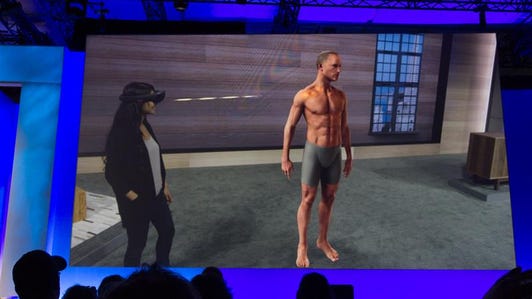Holograms have a date with reality.
On Tuesday, Microsoft revealed that its Windows 10-powered augmented reality headset, HoloLens , will ship to software developers in the first quarter of next year.


Now playing:
Watch this:
Microsoft demos wearable holograms on HoloLens
2:38
“Whether it’s for productivity, health care, design, or entertainment, HoloLens creates experiences that aren’t possible on any other device, or any other platform,” Terry Myerson, executive vice president of Microsoft’s Windows and Devices group said on Tuesday.
The headgear, a fully untethered, battery-operated Windows computer which generates 3D CG objects that appear to exist in the real world, will cost $3,000 for this initial “Developer Edition.”
Sign-ups begin today at Microsoft’s website, and the headset will initially be sold on an invite-only basis.
Check out what the Microsoft HoloLens can do (pictures)






Microsoft emphasizes that this first headset is meant for developers and commercial customers — not consumers. It’s not for playing Minecraft or Halo quite yet. In fact, Microsoft says the initial developer kit won’t be visually or functionally different than the one we tried at E3 back in June, which suggests it could still have a disappointingly narrow field of view .
Still, the technology is impressive: “I want one” was the immediate reaction from more than one CNET staffer.
It’s not like just anyone could buy a HoloLens developer kit and be disappointed, anyhow. Since Microsoft is trying to create a healthy ecosystem for this new category of computer, the company says it isn’t actually taking any money or billing information at this stage.
Related Links
- Microsoft’s Surface Studio: A desktop creation station with a magic dial
- Microsoft’s Surface Books get massive battery life boost
Unlike other recent notable wearable devices like Google Glass and the Oculus Rift virtual reality headset, where anyone could pay and get in line for a developer kit, prospective HoloLens developers will effectively be auditioning for a chance to work with the technology. That’s presumably so Microsoft can control the quality of the initial holographic applications it shows to the public.
Microsoft wouldn’t say how many headsets it plans to offer, or which qualifications it’s looking for in a developer — only that all types of developers will be considered. Software developers will need to be part of the Windows Insider program, and there will be a limit of two devices per applicant. Unless, that is, you’re with a company building a large-scale application for HoloLens. Commercial customers will be evaluated on a case-by-case basis.


Now playing:
Watch this:
5 things you need to know about Microsoft HoloLens
1:39
The HoloLens is joining the nascent market for head-mounted computers, but it’s trailing the pack. When the HoloLens developer kit ships in Q1 2016, it will arrive alongside full consumer versions of the Oculus Rift and the HTC Vive , two competing virtual reality headsets designed to plug into Windows computers.
Facebook, which owns Oculus, also partnered with Samsung to release the Gear VR later this year — a somewhat less capable $99 headset which uses a Samsung Galaxy smartphone as its display and processor. And by the middle of next year, Sony plans to launch the PlayStation VR headset for its PlayStation 4.
Microsoft is positioning the HoloLens as something rather different from those virtual reality headsets, though, which generally require plugging into a PC or game console and obscuring your real-world vision.
Microsoft imagines a future of hybrid applications that blend real and virtual worlds. One example is OnSight, a collaboration with NASA, which lets scientists step into a holographic recreation of Mars.



